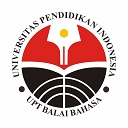Errors in Learning Japanese through Listening-Misheard Cases-
Abstract
This paper aims to study the error that happens when students learning Japanese through listening. This paper describes misheard cases by students during listening class. The data in this research collected from students’ quiz and test results. Students participated in this study were first-year and second-year students, including 37 first-years students and 24 second-year students, with total participants 81 students. The data collected in this study then categorized based on the type of errors. The results showed that the errors occurred include confusion between two sounds, reduction of sound, and mis-guessing long vowel. Confusing of two sounds happened when the students misheard two different sounds such as alveolar nasal consonant /n/ in [hinan] with liquid consonant /r/ as in [hiran]. Furthermore, reduction of sound is occurred when students confused the same vowel at particle with front or back vowel sound of the word, such as yamagaafureru which misheard with yamagafureru. This error occurred because the vowel sound /a/ on particle /ga/ which covering up the vowel sound /a/ in the front of the word afureru. Lastly, there are errors that happened because thin overlapping borderline between error or mistake, where students mostly misheard or mistaken short vowels sound such as [ba∫o] with long vowels such as [ba∫o:].
Keywords
Full Text:
PDFReferences
Al-Khresheh, M. H. (2016). A Review Study of Error Analysis Theory.International Journalof Humanities and Social Research, 2, 49-59.
Ali, A., K. (2012). Error Analysis and Second Language Acquisition.In Theory and Practice in Language Studies, 2(5), 1027-1032.
Brown, H., D. (2007). Principle of Language Learning and Teaching (Fifth Edition).Pearson Education Inc.
Castillejos Lopez, W. (2009). Error analysis in a learner corpus: What are the learners’ strategies? Aelinco Survey of corpus-based research. Retrieved from http://www.um.es/lacell/aelinco/contenido/pdf/45.pdf
Corder, S., P. (1981). Error Analysis and Interlanguage. Oxford: Oxford University Press.
Lennon, P. (2008).Contrastive analysis, error analysis, interlanguage. In Gramley, S. & Gramley, V. (eds.). Bielefeld introduction to applied linguistics: A course book, (51-62). Druck: Aisthesis Verlag.
Nemati, M., & Taghizadeh, M. (2013). Exploring Similarities and Differences between L1 and L2. International Research Journal of Applied and Basic Sciences, 4(9), 2477-2483.
Otake, T. (2007). Interlingual near homophonic words and phrases in L2 listening: Evidence from misheard song lyrics. Proceedings of the 16th International Congress of Phonetic Sciences (ICPhS 2007). Ed. by Trouvain. J. &W. J. Barry. Saarbrucken: ICPhS, 777–780.
Touchi, Y., H. (1986). Second Language Learning Errors Their Types,Causes, and Treatment. JALT Journal , 8(1), 75-80.
Tjandra,S., N. (2004). Fonologi Jepang. Bidang Penelitian Studi Jepang, Universitas Indonesia.
DOI: https://doi.org/10.17509/japanedu.v4i2.18317
Refbacks
- There are currently no refbacks.
Copyright (c) 2019 JAPANEDU: Jurnal Pendidikan dan Pengajaran Bahasa Jepang

This work is licensed under a Creative Commons Attribution-ShareAlike 4.0 International License.
 Published by:
Published by: Department of Japanese Language Education, Faculty of Language and Literature Education
Universitas Pendidikan Indonesia
 Online ISSN: Online ISSN:2528-5548 |

JAPANEDU: Jurnal Pendidikan dan Pengajaran Bahasa Jepang (e-ISSN:2528-5548) lisenced under a Creative Commons Attribution-ShareAlike 4.0 Internasional (CC BY-SA 4.0)


